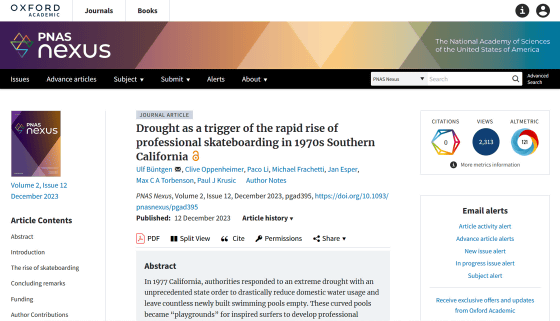Skateboarding emerged in Southern California in the 1970s due to a combination of factors, including severe drought and surf culture.

Drought as a trigger of the rapid rise of professional skateboarding in 1970s Southern California | PNAS Nexus | Oxford Academic
https://academic.oup.com/pnasnexus/article/2/12/pgad395/7462603

How a drought led to the rise of skateboarding in 1970s California
https://www.cam.ac.uk/stories/skateboarding
A Perfect Storm of Culture And Climate Gave Us Pro Skateboarding, Study Says : ScienceAlert
https://www.sciencealert.com/a-perfect-storm-of-culture-and-climate-gave-us-pro-skateboarding-study-says
Professor Ulf Buntgen , from the Department of Geography at the University of Cambridge, said: ``We often look back to the past to point out the link between climate and society, but as we go back in time, the evidence for that link fades. 'We studied skateboarding because we wanted a modern-day example where we could find a lot of data and show that climate influenced human behavior.'
Skateboarding was popular as a hobby for teenagers in the 1950s and 1960s, but at the time it was just a form of entertainment and was not popular enough to become a professional sport. However, the popularity of the freestyle scene exploded in Southern California in the 1970s, and the sport has since become a global industry, with many professionals spawning.
The reason cited for this is the drought that hit California in the 1970s. In the first place, more than 150,000 swimming pools were built in California in the 1960s alone due to the economic boom after World War II. In particular, ``kidney-shaped pools'' with curved walls became popular during this period, and with the construction boom of single-family homes, new kidney-shaped pools were built in the suburbs of Los Angeles, accounting for 60% of all pools in California. He said.
However, in the 1970s, California was hit by a long and severe drought, with 1977 being the driest year of the 20th century, and
It is estimated that California's agricultural sector has suffered a loss of $3 billion (approximately 45 billion yen) due to this drought, and the state water board has imposed strict restrictions such as ``banning the filling of backyard home pools.'' was imposed. This resulted in California's mass-built pools being left empty.
Freestyle skateboarders living in the Los Angeles area took notice of this. In particular, the kidney-shaped pool has curved walls, so it was a perfect environment for freestyle sliding along the wall.
In fact, you can see how young people in the 1970s skateboarded in the empty kidney-shaped pool by watching the video below.
1970's Beverly Hills Pool Skating - Z-Boys - YouTube
Freestyle also borrowed much of its style from surfing, and Southern California was also the epicenter of American surf culture. Therefore, by chance, Southern California at the time had an environment where freestyle skateboarding flourished.
'The popularity and influence of surf culture was essential to the rise of skateboard culture, which is why this movement could only happen in Southern California, ' Buntgen said. 'There may have been an empty pool, but there was no surf culture in Phoenix, so professional skateboarding never happened.'
Furthermore, industrial production of polyurethane began in the 1950s, and its use in skateboard wheels in the 1970s also contributed to its rise. This gives the wheel grip and sturdiness, making it possible to glide faster than previous metal wheels.
In the 1980s, skateboarding became a global industry, and the spread of consumer video cameras, which made it possible to record videos of skateboarding, also spurred its popularity. Skateboarding was adopted as a summer Olympic sport for the first time at the 2021 Tokyo Olympics, and now skateboarding has a market worth billions of dollars (hundreds of billions of yen).

“We often think about the negative effects of climate change, but our research shows that regional climate change can have unexpected effects on human society, all of which have negative consequences,” Buntgen said. In this case, a drought in California led to the development of a huge industry.If we think a little deeper, we understand that climate and environmental factors deeply influence society. This confirms the idea: such developments are not random, and in the case of skateboarding, each element had to exist in the same place and time: 10 years ago, 10 years later, or a few years later. It couldn't have happened a hundred miles away.'
Related Posts:







